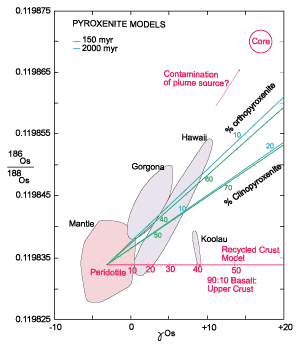 |
 |
Pt-Os
isotope systematics do not prove an ultra-deep
origin for intraplate volcanism |
|
|
| |
Abstract
Suprachondritic 186Os/188Os
ratios in intraplate volcanic rocks have been interpreted
as indicating incorporation of outer core material
into plume sources. Such signatures may, however,
also be generated in pyroxenites precipitated from
MgO-rich melts by the preferential incorporation of
Pt relative to Os in ortho- and clinopyroxenes. The
186Os/188Os signatures do not
therefore give any indication of depth of origin,
and are compatible with shallow-source models for
intraplate volcanism.
|
Variations in osmium isotopic composition result
from the alpha decay of 190Pt to 186Os
and the beta decay of 187Re to 187Os.
Suprachondritic 187Os/188Os
ratios in intraplate volcanic rocks have generally
been used to support plume models for generation of
this type of volcanism from recycled oceanic crust.
The Pt-Os system has been applied to comparatively
few rock types on account of the long half life of
190Pt and corresponding small variation
in 186Os abundances. Analyses of Hawaiian
picrites and Gorgona Island komatiites have also revealed
suprachondritic 186Os/188Os
ratios (186Os/188Os = 0.119832
to 0.119854) in intraplate volcanic rocks [Brandon
et al., 1998; 2000; 2003].
A problem for the crustal recycling model is, however,
that the coupled 186Os/188Os
-187Os/188Os variation in such
samples lies above mixing lines between recycled crust
and peridotite compositions. The intraplate signatures
have therefore been interpreted as resulting from
entrainment of small amounts (1%) of outer core material
[186Os/188Os estimated between
0.118952 and 0.118973, Brandon et al., 1998;
2000; 2003] into plume sources. This maintains the
concept of an ultra-deep origin for this category
of volcanism.
This interpretation is, however, non-unique. High
Pt/Os and Re/Os ratios, which should lead to generation
of suprachondritic 186Os/188Os
-187Os/188Os, are also features
of pyroxenites precipitated from MgO-rich melts such
as bonninites [Smith, 2003]. Using average
Pt/Os and Re/Os ratios of pyroxenite dykes from the
Bay of Islands ophiolite complex [orthopyroxenite:
Pt/Os = 199, Re/Os = 3.9; clinopyroxenite: Pt/Os =
264, Re/Os = 7.1 Edwards, 1990], it can be
calculated that the 186Os/188Os
and 187Os/188Os signatures found
in intraplate picrites and komatiites could be produced
from peridotite:pyroxenite mixtures containing 30
– 60% pyroxenite in 150 million years. This
corresponds to the lifetime of oceanic lithosphere
[Smith, 2003]. If isotopic evolution took
place over the longer time period of 2 billion years,
as might be appropriate for evolution in a continental
mantle reservoir, the required percentage of pyroxenite
would decrease to 5 – 10%.
|
| Figure:
The 186Os/188Os and 187Os/188Os
isotopic variation in the depleted mantle and intraplate
volcanic rocks (after Brandon et al., 2003).
187Os/188Os ratios are expressed
in terms of gamma-Os which represents the percent deviation
from the chondritic 187Os/188Os
ratio at a given time. The low Pt content of basaltic
crust causes mixing lines between recycled basalt:sediment
mixtures and peridotite to have a shallow trajectory
irrespective of the type of sediment involved. Plume
models must therefore invoke contamination with outer
core material to explain the isotopic signatures observed
in Gorgona komatiites and Hawaiian picrites. However,
the plume model is not proven as the intraplate arrays
may also be generated from pyroxenite:peridotite mixtures
(mixing lines from Smith, 2003) which could
be formed at shallow levels in the mantle. Tick marks
on mixing lines indicate 10% increments in all models. |
 |
The
observed Os isotopic signatures therefore do not “prove”
the existence of plumes from the core-mantle boundary,
and models for the derivation of intraplate volcanism
from shallow sources are more compatible with the observations
[Smith, 2003]. |
-
Brandon, A.D., M.D. Norman, R.J.
Walker, and J.W. Morgan, 186Os-187Os
systematics of Hawaiian picrites, Earth planet.
Sci. Lett., 174, 25-42, 2000.
-
Brandon, A.D., R.J. Walker, J.W.
Morgan, M.D. Norman, and H.M. Prichard, Coupled
186Os and 187Os evidence for
core-mantle interaction, Science, 280,
1570-1572, 1998.
-
Brandon, A.D., R.J. Walker, I.S.
Puchtel, H. Becker, M. Humauyn, and S. Revillon,
186Os-187Os systematics of
Gorgona Island komatiites: Implications for growth
of the inner core, Earth planet. Sci. Lett.,
206, 411-426, 2003.
-
Edwards, S.J., Harzburgites and
refractory melts in the Lewis Hills massif, Bay
of Islands ophiolite complex: The base-metals and
precious-metals story. Canadian Mineralogist 28,
537-552., Canadian Mineralogist, 28,
537-552, 1990.
-
Smith, A.D., Critical evaluation
of Re-Os and Pt-Os isotopic evidence on the origin
of intraplate volcanism, J. Geodyn., 36,
469-484, 2003.
|
last
updated 19th May, 2004 |
|
|
